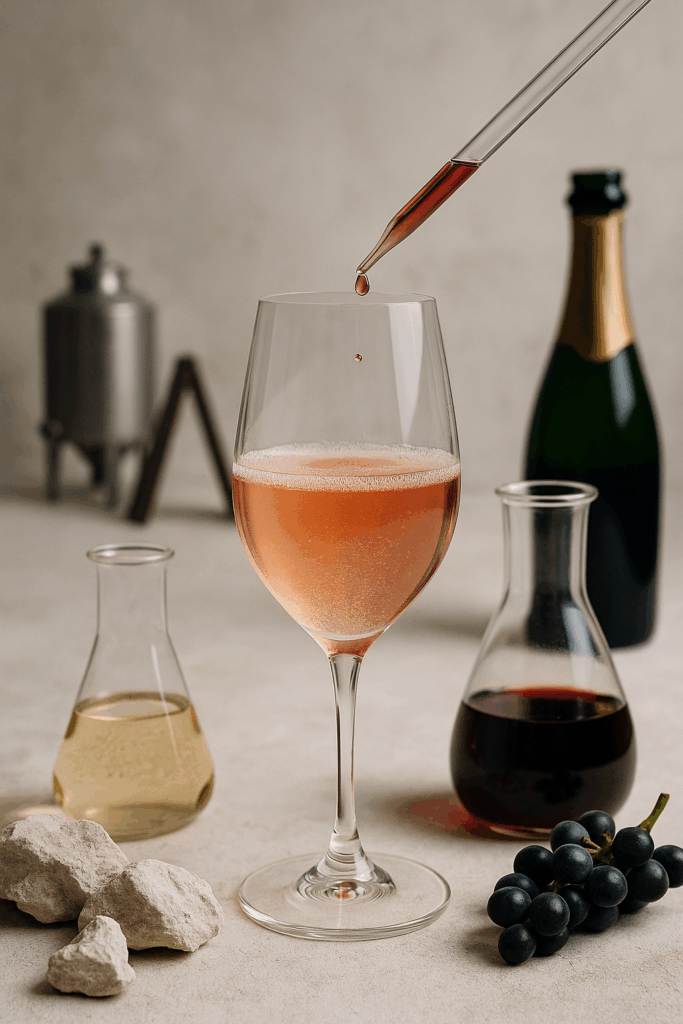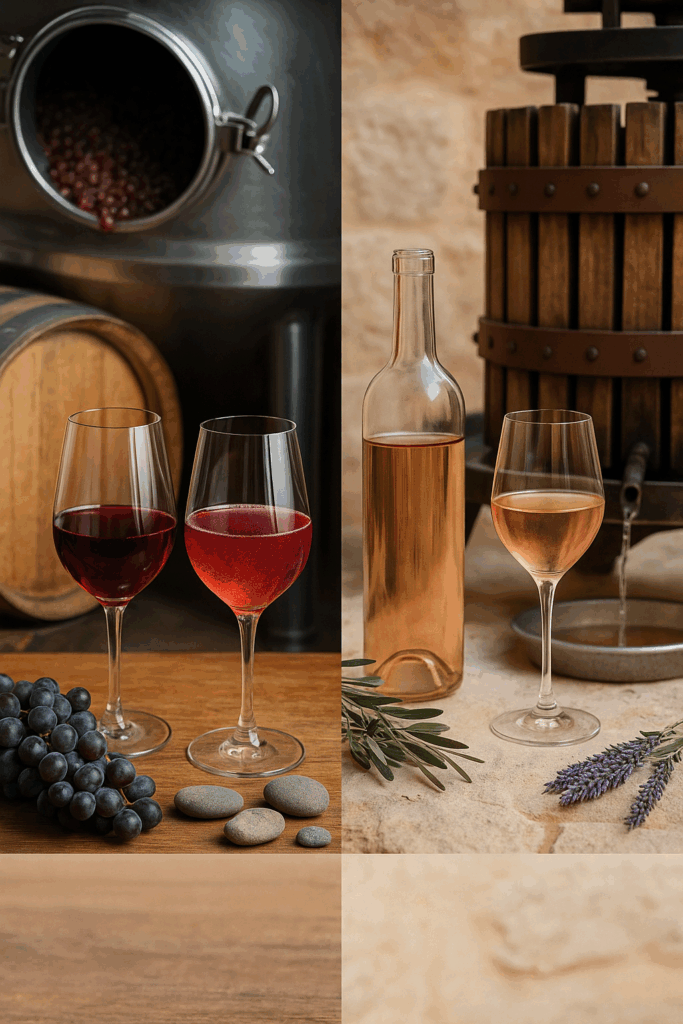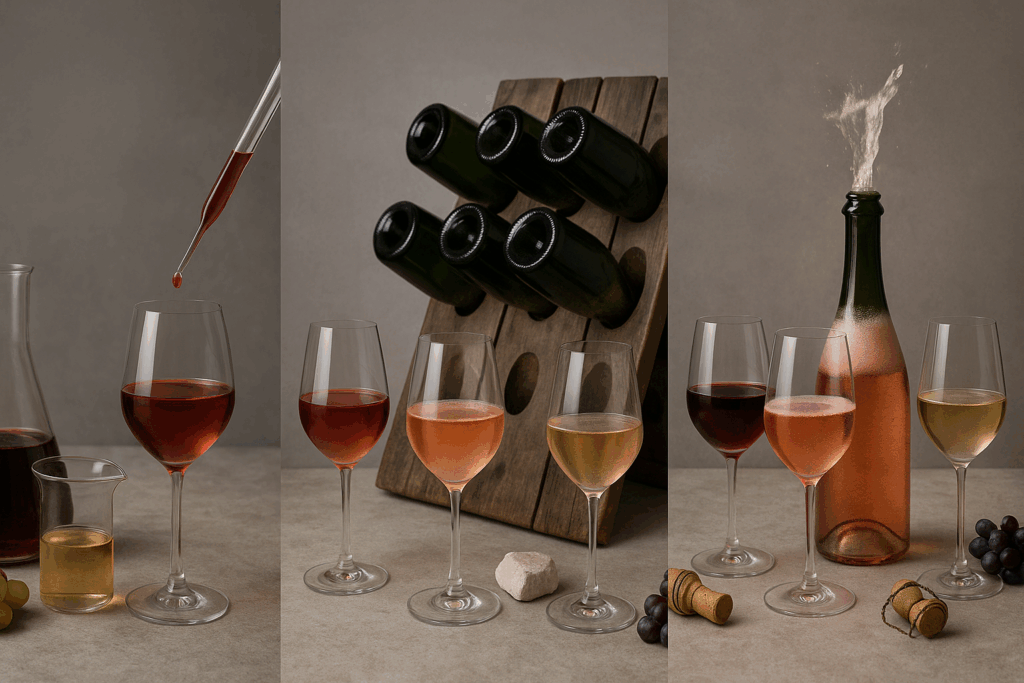Rosé Champagne, the unique rosé d’assemblage explained
Ik kende Rosé Champagne vooral uit de boeken. Op papier vond ik het vreemd: een roze mousserende wijn die je maakt door witte basiswijn te blenden met een deel stille rode wijn. Pas toen ik in Hautvillers stond, tussen de kalkhellingen en de abdij, proefde ik het zelf en viel het kwartje. De kleur was niet alleen fraai; de wijn had spanning, verfijning en een onverwachte diepte in geur. Die proefervaring leerde me wat rosé champagne in de praktijk is: precisie in kleur, geur en structuur. Over die ervaring vertel ik uitgebreider in mijn eerste stappen in Hautvillers.
Rosé d’assemblage, the Champagne exception
In France, rosé is normally made by short skin contact (saignée) or by direct pressing (presse). Rosé Champagne is the exception: here you may make a rosé d’assemblage, meaning blending still white wine with still red Pinot Noir or Meunier before the second fermentation in bottle.
Dat is geen trucje maar pure precisie: met enkele procenten rood (vaak enkelvoudige cijfers tot lage tieners) stuur je op tint, aromatiek en textuur. Zo ontstaat rose Champagne met een herkenbare, verfijnde signatuur. Wil je de terroir-laag beter begrijpen, verdiep je dan in de crus of Champagne.


Other methods in context: saignée and direct pressing
Saignée voelt als thuiskomen. In Bordeaux worden veel rosés via korte schilweking gemaakt, waardoor ze wat meer kleur, beet en kruidigheid hebben; nog dichter bij huis herken ik hetzelfde profiel in of wine from Bergerac. Bij Bordeaux rosé en Bergerac rosé proef je vaak meer kleur, grip en rood fruit door de schilweking.
Clairet also belongs to that family: a traditional Bordeaux style that sits between rosé and light red, with longer maceration and therefore a deeper color and fuller mouthfeel. It is essentially a subtype of saignée, firmly rooted in the local food culture.
At the other end of the spectrum is rosé de presse. In Provence, rosé de presse is the signature style: direct pressing produces pale, precise, and aromatic Provence rosé. It is no coincidence that it is the worldwide reference profile for pale, delicate rosé.
The art of blending in Champagne
Wat mij in Hautvillers overtuigde, is het bouwende karakter van assemblage. Je maakt eerst de beste mogelijke stille basis (meestal een mix van druivenrassen, jaargangen en dorpen) en voegt daarna precies genoeg stille rode wijn toe. Vóór tirage (bottelen met liqueur de tirage) staat de kleur en het fruitprofiel vast; op de gisten groeit vervolgens de fijne mousse en autolyse-complexiteit. Na rijping op fles volgt disgorgement en een dosage die de balans finetunet. Ook flesmaat en rijping spelen mee; lees voor context over vormen en volumes meer bij wijnflessen.
Taste and style: how do you taste the difference?
- Rosé d’assemblage (Champagne): usually salmon pink to light pink, precisely measured red-fruit aromas, tight and chalky in the finish. The mousse carries the fruit.
- Rosé de saignée (including clairet): deeper in color, a bit more body and grip, more pronounced red fruit; often gastronomically stronger than you think, especially with southwestern French dishes.
- Rosé de presse (Provence): very pale, delicate and refreshing; modern Provence rosé is the template for summer elegance.

Why this exception matters
In Frankrijk is blenden van wit en rood tot een stille rosé verboden; Champagne mag wél blenden omdat het om mousserende wijn gaat en het mengen vóór de tweede gisting gebeurt. Dat onderscheid verklaart ook het beeld van rosé in Frankrijk: maceratie of persing voor stil, assemblage voor mousserend. Deze juridische lijn is geen voetnoot maar een identiteitsfactor: zij verklaart waarom Rosé Champagne tegelijk feestelijk, precies en gastronomisch kan zijn, anders dan de rosés waarmee ik ben opgegroeid in Bordeaux en in wijn uit Bergerac, en anders dan het Provence-presse-ideaal. Zin in een aperitief-alternatief binnen het zoet-/fortified-spectrum? Lees dan ook eens over VDL vs. VDN (vin de liqueur).
Serving and storing: small choices, big impact
Serveer op 8–10 °C; die serveertemperatuur Champagne houdt de mousse fijn en het fruit zuiver. Kies een tulpglas of een klein witwijnglas, de iets bredere kelk vangt meer geur en laat de textuur spreken; vind jouw ideale glas in verschillende soorten wijnglazen. Bewaar flessen koel en trillingsarm; een wijnklimaatkast helpt je constant te blijven (beste wijnklimaatkast). Schenk rustig langs de wand en vul niet te hoog; zo blijft het bouquet open.
At the table, aperitif to fine dining
Think of Rosé Champagne as high in acidity, with fine mousse and subtle red fruit..
- Aperitif & raw seafood: sushi, sashimi, ceviche, oysters (clean acidity, fruity echoes).
- Hartig & gevogelte: charcuterie, gevogelte (ook eend), kalf; werk met harmonie van wijn-spijs wanneer smaken parallel lopen, of speel met de kunst van contrast als je spanning wil. Voor jus en sauzen vind je ideeën bij sauces with wine–food pairings and regional wine food pairing.
Maak je menu visueel af via harmony of color en check algemene combinatieregels bij wijn-spijs.
Finally: taste with an open mind
I once went to the hills of Champagne skeptical and came back with a new appreciation for rosé d’assemblage. If you want to feel that nuance at the table too, start with a good producer, serve at 8–10 °C in the right glass, and when tasting watch the balance between purity, mousse, and soft red fruit. I bet you’ll taste the difference.
Is rosé d’assemblage allowed outside Champagne?
For still rosé, blending white and red is forbidden in France. For sparkling rosé, the EU does allow it; Champagne is the best-known region that deliberately uses this. Other French sparkling wines can technically do it too, but in practice many producers opt for pressing or saignée.
How much red wine typically goes into Rosé Champagne?
Usually 5–20% still red Pinot Noir or Meunier. Lower (5–10%) gives a salmon-pink, refined style; higher (10–20%) brings more color and red fruit. The exact percentage depends on house style, vintage, and the intended gastronomic use.
How can you tell the difference between rosé d’assemblage and rosé de saignée?
In the glass, assemblage is often paler and tighter; saignée is deeper in color, a bit fuller, and with more grip. The method is rarely stated explicitly on the label. If “rosé de saignée” is mentioned, it is maceration; if nothing is stated, it is usually assemblage (but not 100% certain without a technical sheet).
What is the best serving temperature, and which glass should you use?
Serve at 8–10 °C; colder masks the aromas, warmer makes the mousse coarser. Preferably use a tulip glass or a small white wine glass: the wider bowl captures more aroma and shows the texture better than a narrow flute.
What does Rosé Champagne pair best with (and what should you avoid)?
Top pairings: sushi and sashimi, ceviche, scallops, charcuterie, poultry (including duck), and red-fruit desserts. Avoid very sweet desserts with Brut (the wine will seem harsh) and dark chocolate, unless you choose a sweeter style (sec/demi-sec) or deliberately use another wine for contrast.
